The red cherry shrimp is a popular invertebrate for beginner to experienced aquarists. They’re easy to keep and add vibrant color to aquarium displays.
In fact, this hardy and undemanding dwarf shrimp species is easily one of the most popular inverts in the aquarium trade.
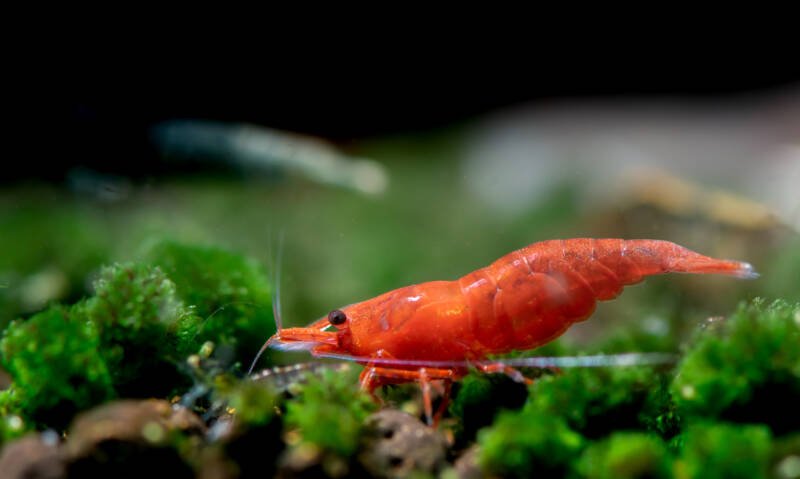
At a glance
| Size: | 1.5 inches (3.8 cm) |
| Lifespan: | 1-2 years |
| Minimum tank size: | 5 gallons (20 l) |
| Group size: | ~10, 2-5 cherry shrimp per gallon |
| Temperature: | 65-85°F (18-29°C) |
| pH: | 6.5-8.0 |
| Water parameters: | 0 ppm ammonia, 0 ppm nitrite, < 20 ppm nitrate |
In this article
Red cherry shrimp vs Neocaridina davidi
The red cherry shrimp, Neocaridina heteropoda, is a peaceful, algae-eating freshwater shrimp.
Another species of cherry shrimp, Neocaridina davidi, had previously been incorrectly classified as the red cherry shrimp. But N. davidi are naturally colored green-brown, though variations of blue, black, orange, and red exist.
Cherry Shrimp Color Grading

Neocaridina heteropoda, the red cherry shrimp, is of course red. However, due to years of selective breeding within the aquarium trade, shades of red in the cherry shrimp vary.
A system known as color grading is used to classify the different shades of red, an indicator of how expensive and rare an individual shrimp or group of shrimp are.
The grades range from the deepest, most complete red coloring to paler, red-spotted coloration.
The regular cherry shrimp is the lowest grade; they are mainly clear in color with red patches.

Next up is the sakura cherry shrimp, which are redder in color, but clear patches still remain.
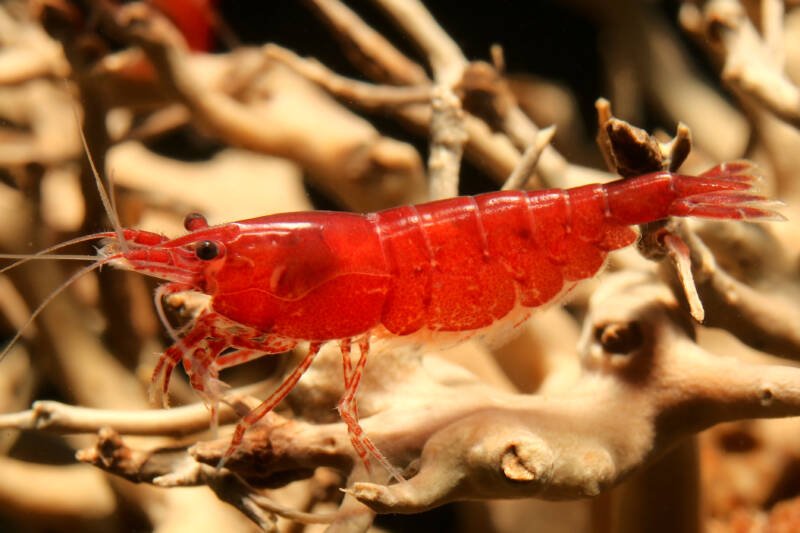
At the next grade, the fire red shrimp is completely red.

The most expensive and highest grade is the painted fire red shrimp, which are solid red, including their legs, with no transparent areas.

Coloration can also be an indicator of how content your cherry shrimp are.
Their color will remain vibrant when healthy and well-fed with low-stress levels. This care guide breaks down exactly how to keep your shrimp happy and aquariums vibrant.
In the Wild
This freshwater shrimp is native to the rocky, planted communities of streams and ponds in Taiwan.
These omnivores will eat basically anything in the wild, both scavenging and feeding off of algae.
Behavior
Cherry shrimp have a peaceful temperament and are not at all aggressive.
This incredibly active species will be a buzz during the day and night. They spend most of their time grazing on live plants, moss, and substrate around their environment.
They do best in environments with plenty of plants, rocks, and other décors to provide shelter and hiding spots. Their sense of safety is important for their health, especially when molting.
As your cherry shrimp grows, they will occasionally shed their exoskeleton.
Here is where those hiding spots come in, as your shrimp will seek shelter throughout this time.
It’s also important to leave the exoskeleton in the tank so the shrimp can consume it to replenish vital nutrients.
Tank Setup
Cherry shrimp can be kept at 2-5 individuals per gallon, with groups of at least 10 being ideal.
Start your tank set up with a rocky substrate, such as small pebbles, to mimic their natural stream environment.
Once again, you’ll want to create a heavily planted community with sheltered areas and hiding spots.
Live plants are ideal for shrimp tank setup, good options include Java Fern and Water Wisteria.
Moss is also important to include for your cherry shrimp. Java moss is a great choice, your shrimp will use it to groom themselves and to hide and scavenge within.
Driftwood can also be nice to include in tanks. The shrimp will nibble algae growth from the driftwood.
All of this live plant matter to forage on throughout the aquarium can actually make up a reasonable portion of their diet.
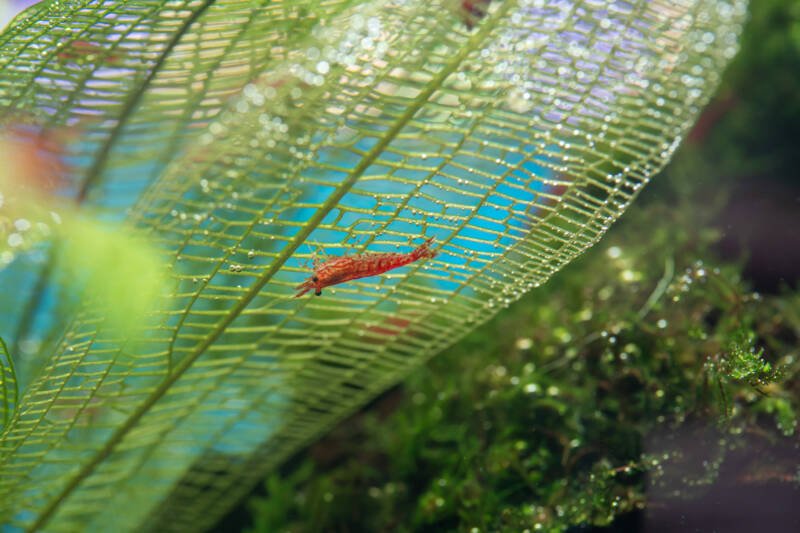
Remember, when your cherry shrimp are healthy and feel safe, they’ll display their brightest colorations.
You can use this as an indicator of the quality of your aquascaping.
A common issue aquarists run into with tank setup is using a filter that’s too powerful.
This can lead to shrimp getting sucked into them and thus mortalities. Utilizing a sponge filter can help you dodge this dilemma.
Alternatively, you can reduce the flow of more powerful filters, such as canisters, with foam inlets. If you want, air stones can always be added for additional water oxygenation.
Heaters are not typically needed to maintain the shrimp’s ideal water temperature. As long as the room temperature remains between 65-85°F (18-29°C) the tank setup should not require a heater.
In terms of lighting, you’ll want to provide both dark and light areas for your shrimp during the day.
Where there’s light, there’s algae growth, which the shrimp will feed on. But they also prefer their hiding spots and shelter to be darker.
Water preferences
Water hardness should remain medium to hard, between 6-8 dGH. A pH range should be kept between 6.5-8.0.
Ammonia and nitrite levels should be maintained at 0 ppm, and nitrate levels should remain around < 20 ppm.
It’s important that the cherry shrimp are added to a fully cycled tank system.
These shrimps are particularly sensitive to nitrites, so don’t place any in an uncycled tank!
Tank Mates & Compatibility
When selecting tank mates, pick carefully as these inverts are defenseless, meaning they can quickly turn into food for other fish.
Here are some of our favorite safe tank mates to pair with the cherry shrimp:
- Otos
- Freshwater snails
- Freshwater crabs, like pom-pom
- Bamboo shrimp
- Amano shrimp
- Ghost shrimp
- Small corys, like pygmy.
To pair with caution (if you don’t want to breed your shrimp):
Even with compatible fish tank mates, the cherry shrimp may still be mistaken for food. It’s likely that their breeding will counterbalance the occasional causality.
Once again, it’s important to include plants and sheltered spaces so these animals can hide when they need to, their sense of safety reflected in the vibrancy of their color.
Yet the ideal tank mate for the cherry shrimp is more cherry shrimp. A species-specific tank is a favored way for hobbyists and aquarists to house these shrimp.
If you plan to house your cherry shrimp in a species-specific shrimp tank, you should keep them in a group of 10 or more.
This minimum provides the benefits of limiting dominance behavior and building group confidence, which leads to more natural behaviors.
Food & Diet
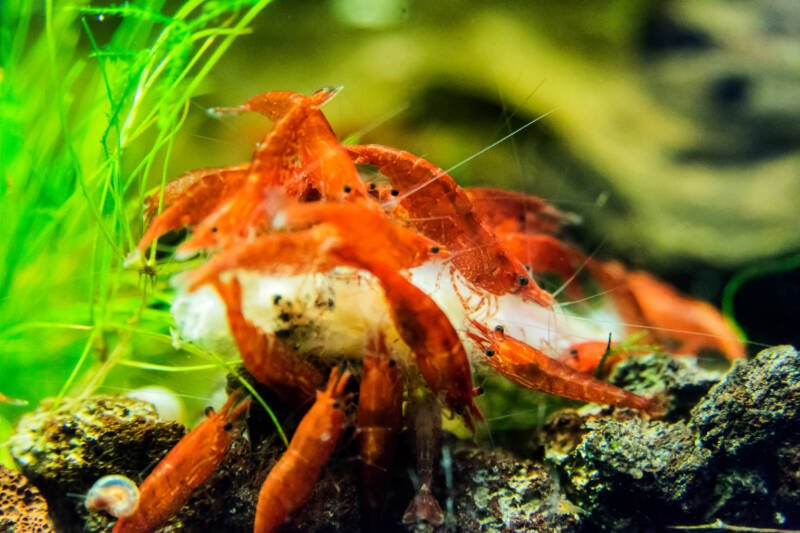
These omnivores eat a varied diet. They’ll spend a good portion of their time scavenging for food particles within the rocky substrate or feeding on algae and moss growth.
In fact, the cherry shrimp is known for its algae cleaning abilities.
As the core of their diet, you’ll want to include a high-quality pellet food that is made specifically for shrimp and invertebrates.
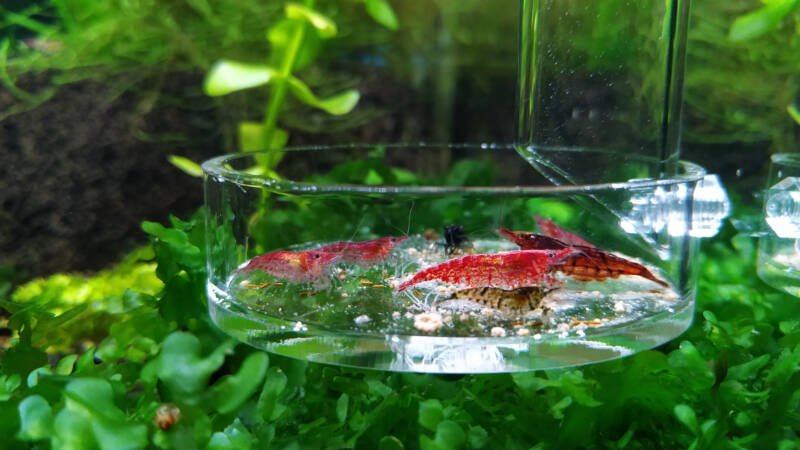
Their diet can also be supplemented with frozen foods and veggies.
Spinach, carrots, lettuce, cucumber, and zucchini are good at-home options for feeding your cherry shrimp.
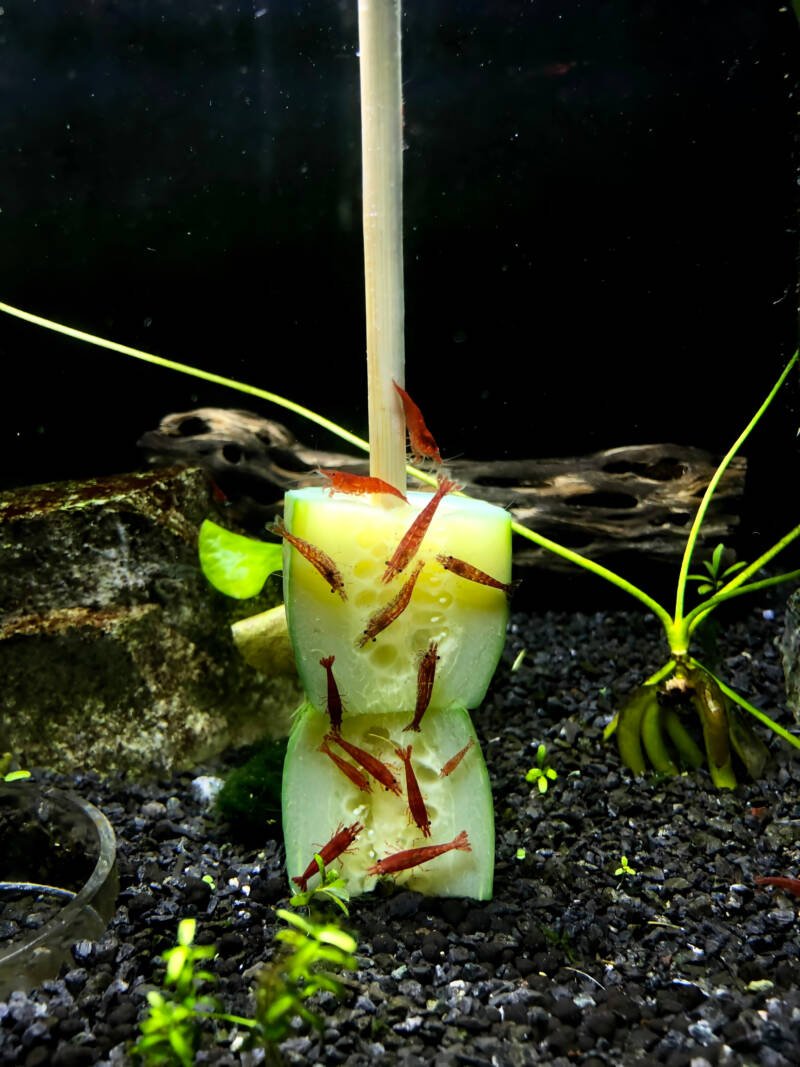
Make sure they are boiled or blanched, and you’re not feeding these vegetables raw.
You’ll want to be mindful of overfeeding your shrimp tank. Leftover food can easily muck up your tank.
In general, it’s good to keep an eye on overfeeding and remove extra food from the tank to help maintain water quality.
Breeding
This species will breed quickly, which may be important to consider when selecting an aquarium size. It may be better to go too big than too small.
If you’re intending to breed your cherry shrimp, you should have at least a 20-gallon tank (75 l).
You don’t need to worry too much about specific gender ratios but ensure there are more females than males in the breeding community.
Once again, you’ll want to make sure you’re breeding tank is outfitted with plenty of plants for their comfort.
Cherry shrimp reaches sexual maturity around 4 to 6 months of age.
If your shrimp are already sexually mature, you can expect around 3 to 5 months before they’re settled into their new environment to begin breeding.
The first step to induce breeding is to raise the water temperature to around 82°F (28°C) to mimic the start of their summer breeding season.
It will be obvious once breeding has occurred, females will have many eggs on display underneath their tails. During this time, the females are referred to as berried.
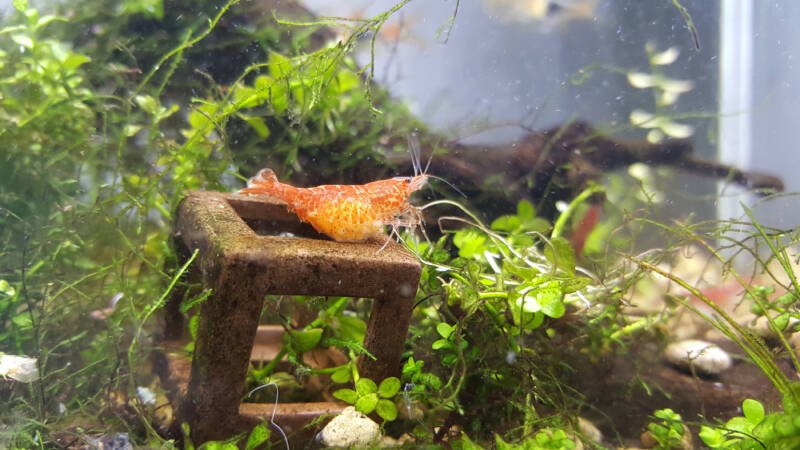
You may see your berried females fanning their tails, this is to keep their eggs oxygenated.
The eggs will hatch after about 30 days, and the baby shrimp will look like small replicates of the adult cherry shrimp.

No additional parental care is given after this point. Do not cohabitate baby shrimp with any predators as they make easy prey.
Live moss will help protect the young shrimp and provide food as the babies grow.
Sexing
As babies, it’s impossible to determine the shrimp’s gender. However, as they mature, the differences between males and females will become more distinct.
Female cherry shrimp will develop a saddle on their stomach. This saddle is used to carry eggs and tends to be orange in color.
Additionally, females will always be larger and, regardless of grading, more colorful than males.
Hardiness and Diseases
Cherry shrimp can become afflicted with bacterial and fungal infections as well as parasites.
Bacterial infections can be hard to identify and equally difficult to treat; however, recognizing fungus and parasites can be easier.
Fungal infections can be unavoidable; there are spores everywhere in the air and water.
Healthy shrimp should be able to fight off infections fine, but be sure to separate the infected shrimp from the rest of the population.
Fungal treatments will usually help rectify the situation.
Parasites are not always a death sentence. Some even live in symbiosis with the shrimp. Performing a salt bath with aquarium salt will get rid of unwanted parasites.
This same treatment will help with another disease that’s not too uncommon in these shrimp, vorticella.
Vorticella is an aquatic organism known as protozoa. They attach themselves to the shrimp and will look like a fuzzy white mold or fungus.
It’s essential to treat your cherry shrimp with freshwater aquarium salt to get rid of the Vorticella. Vorticella has been known to cause death in untreated shrimp.
Finally, like most invertebrates, cherry shrimp are incredibly sensitive to copper. Be cautious of fish food or medications that may contain this metal.
Closing Thoughts
The cherry shrimp can brighten up your aquarium and your day. Active, vibrant, and peaceful, this is a great species for beginners as they are far from demanding in their care requirements.
The cherry shrimp is an incredibly hardy species that will thrive in nearly any freshwater aquarium setup.
Whether you opt for a shrimp-specific-species tank or add them to an existing tank with compatible cohabitants, you should have an easy time with this invertebrate.
When purchasing your cherry shrimp, you can expect to pay between $1.50 – $8.00 per shrimp, depending on their grade.
For a regular cherry shrimp, you’ll likely spend between $1.50 – $3.00.
If you have additional questions about caring for your cherry shrimp population or comments and suggestions on our care guide, please feel free to reach out!